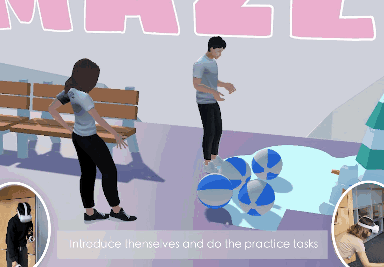VR | Game | Research | Interaction
M21 Design Project
2022
Co Maze: The Effect of Identifiable Representation Avatar in
Social Virtual Reality Communication

Project Summary
Virtual Reality (VR) has gained significant attention as a powerful tool for communication. Previous research has extensively studied the impact of various social media platforms on communication. In recent years, researchers have focused on enhancing the immersive social communication environment in Social Virtual Reality (SVR).
This experiment aims to investigate the effect of identifiable representation avatars on social presence and social communication in a collaborative task-oriented SVR setting. The results indicate that identifiable representation avatars have a negative influence on social presence, while anonymous avatars facilitate more effective communication in task-oriented social cooperation.
Research Introduction
In order to provide a collaborative social environment where participants can communicate and establish a sense of presence with each other, the CoMaze was developed. The participants are tasked with navigating through a maze together, and communication occurs naturally without any constraints during the experiment.
The design of the CoMaze underwent iterative improvements based on feedback from experts and pilot tests. Additional tools to facilitate communication and collaboration can be incorporated into the scene, and specific visual cues are essential in a complex scenario such as a maze. The final game evaluation environment is in Figure 1.

Figure 1 Overview of the maze world
Avatar Creation and Application
In this experiment, two types of avatars were utilized. In the experimental group, avatars with identifiable representations were provided, created using pictures of the participants with personal information,. Conversely, in the control group, non-identifiable representations were used, consisting of robot-like avatars provided by VRChat without any personal identity information. (Figure 2)


Figure 2 Participants with avatars
Experiment Procedure
The experiment took place at Eindhoven University of Technology, involving a total of 32 participants (19 males and 13 females). The participants were randomly divided into two groups: group A, which received avatars generated from their own pictures, and group B, which received anonymous robot avatars. Each group consisted of 16 participants who joined the test in pairs. The entire experiment lasted approximately 25 minutes for each group, with an average playing time of around 10 minutes in the virtual world, including practice tasks and a maze game.
The entire procedure is illustrated in Figure 3.
Figure 3 Experiment Procedure

Analysis
The original quantitative experimental data includes data from the ’Networked Minds Questionnaire’ and the completion time of participants. There are 32 sets of valid data, from two groups in total. The data from the questionnaire are firstly analyzed by a reliability analysis. Reliable factors are further analyzed by mean difference analysis and ANOVA.
Also, the qualitative data are collected by observing the participants' game-playing experience.
